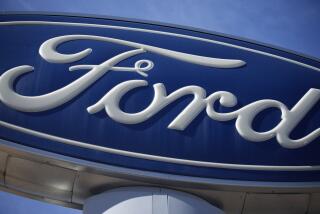Detroit’s state of mind
- Share via
It doesn’t take much to rile outspoken General Motors Corp. Vice Chairman Bob Lutz, especially when the conversation turns to the Japanese automakers.
“The media perpetuates that if you are cool, you buy an import, and if you can’t read, you buy a domestic,” he griped recently.
Lutz also becomes a bit unhappy when the conversation turns to the fact that Nissan Motor Co. will join Toyota Motor Corp. this year in offering a full-size pickup truck in a segment long dominated by the domestics.
“Consumers have been disappointed with our cars in the past, which led to the exodus out of our cars and into Japanese cars,” Lutz said. “But consumers haven’t been disappointed with our trucks. No one has said: ‘Now that Toyota has a truck -- I’m getting out of my Chevy and into a Tundra.’ That’s not going to happen.”
The 2000 Toyota Tundra, with its V-8 engine, was the first true full-size pickup from a Japanese automaker. In December, the Nissan Titan will become the second.
The Chevrolet Silverado accounts for about 650,000 units annually, second to about 800,000 for the market leader, the Ford F-150. The Tundra sells only 100,000 units, the target Nissan has set for the Titan.
Toyota and Nissan say their trucks are intended for their current customers who own compact pickups and need to move up to something bigger.
However, Nissan notes that the Titan is slightly bigger than the F-150 and will offer a bigger V-8 engine, which certainly sounds as if the Japanese company intends to lure a few drivers out of the F-150, if not also the Silverado, and into a Titan.
Time will tell.
With the pickup truck market reasonably secure in U.S. hands, what will it take to get back those consumers who made an exodus to imported cars from domestics?
Lutz’s answer: “Fresher product -- and we have that coming -- a stronger economy and import pricing that takes into account exchange rates, plus limited- edition, gotta-have vehicles like the Chevy SSR and Cadillac XLR, cool stuff that gets back the attention of the public and gets opinion leaders to change their attitudes about us and tip the opinions of others.”
Jim Padilla, president of Ford’s North American automotive operations, says fresher product will help domestic automakers, but so will a stronger economy and, especially, more favorable exchange rates.
The weaker the yen, the more you get for a dollar and the more money the Japanese make, so they don’t need to raise prices to post a profit.
At the moment, the exchange rate is about 118 yen to the dollar, whereas in the mid-’90s it was about 90 yen to the dollar.
“The Japanese have taken huge advantage of exchange rates,” Padilla said.
But will domestic automakers take full advantage if the yen strengthens? In the mid-’90s, the strong yen forced the Japanese to raise prices.
“The Japanese raised prices quickly and substantially based on the exchange rates, but Detroit raised prices too,” said industry analyst Art Spinella, general manager of CNW Marketing/Research in Bandon, Ore.
Detroit could have held prices steady, taken advantage of exchange rates and undermined Japanese market share, “but if Toyota went up $50, the Detroit automakers went up $49,” Spinella said, calling the American manufacturers’ moves shortsighted.
Incentives have become a staple of the auto industry. Will they ever go away?
“That’s the same question people asked in the ‘80s,” said Ford President Nick Scheele. “Incentives may never go away, but as the economy gets stronger you’ll have less incentives,” as was the case in the mid-’90s.
“You can’t bet on a home run every year; that’s like betting on double zero coming up every time on the roulette wheel,” he said. “But we have new product coming at lower volumes, so we won’t have to incentivize the new product.”
More to Read
Inside the business of entertainment
The Wide Shot brings you news, analysis and insights on everything from streaming wars to production — and what it all means for the future.
You may occasionally receive promotional content from the Los Angeles Times.










